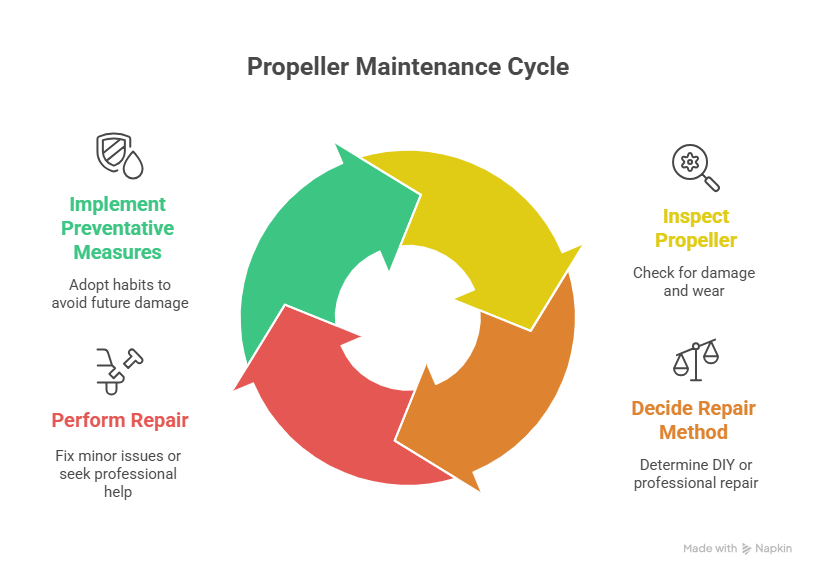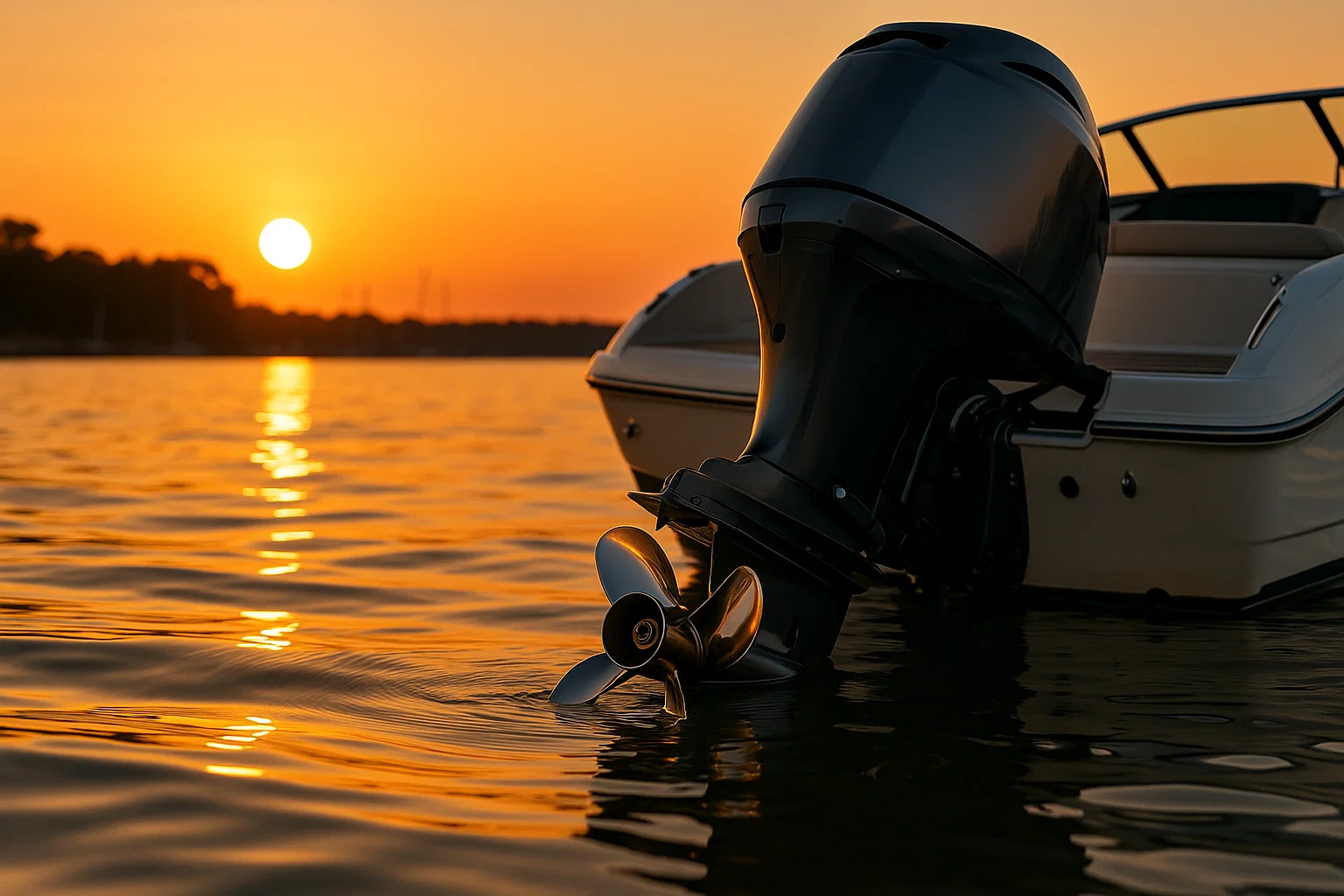Saving Your Boat’s Propeller: My Miami Marina Repair Playbook
I’ve been fixing boats in South Florida since 2010, starting with my dad’s old Sea Ray in a sweltering Fort Lauderdale garage. That gut-wrenching thud when your prop hits a sandbar? It’s a boater’s nightmare—vibration rattling your teeth, engine straining. Last July, Carlos at Dinner Key Marina limped in with his Yamaha SX210’s prop nicked from a reef graze; my $200 fix saved him a $1,500 replacement. Here’s my hands-on guide to inspecting, repairing, and protecting your propeller like a pro. It’s about knowing when to DIY, when to call a shop, and how to keep your ride humming.
Why Does a Damaged Propeller Matter So Much?
Your prop’s not just a spinner—it’s the heart of your boat’s performance, turning engine power into thrust. I learned this in 2012 when a client’s Bayliner 265 vibrated like a jackhammer from a bent blade—$2,000 in gear damage followed. A dinged prop messes with speed, fuel, and your engine’s life.
What Happens When a Propeller’s Damaged?
A nick isn’t just cosmetic. Last June, Sofia at Key Biscayne brought me her Boston Whaler with a scuffed prop—sluggish and guzzling gas. Here’s the ripple effect:
- Vibration: Shakes your drivetrain, chewing up seals and bearings.
- Performance Drop: Nicks cause drag, slowing acceleration and top speed.
- Fuel Burn: A damaged prop makes your engine work harder—$50 extra per trip.
- Blade Loss: Cracks can snap blades at high RPMs, risking hull damage.
Feel vibration? Stop boating. I caught a spun hub on a Grady-White last month—saved a $3,000 lower unit repair.
How Do I Diagnose Prop Damage Like a Pro?
You can’t fix what you don’t see. I’ve pulled 200+ props in Miami’s marinas, and a proper inspection catches issues before they’re a crisis. Here’s how I do it.
How Do I Inspect My Propeller Properly?
- Safety First: Disconnect the battery and pull the key. I saw a guy skip this in 2013—nearly lost a finger.
- Remove the Prop: You can’t spot hidden damage with it on. Use a prop wrench and block of wood to avoid dings.
- Clean It: Scrub with a wire brush and degreaser to clear marine growth. Fishing line on the shaft’s a seal-killer—found some on a Yamaha last July.
What’s My Four-Point Inspection Checklist?
On the workbench, check:
- Blade Edges: Run a gloved finger along edges for nicks or burrs.
- Bends: Sight down each blade—any warp throws balance.
- Cracks: Check blade roots with a magnifying glass; hairline cracks spell trouble.
- Hub and Shaft: Look for a spun hub (marker test: draw a line across hub and prop; misalignment after a run means it’s spun). Check shaft splines for wear.
I photographed a Sea Ray’s cracked blade at Coconut Grove in 2024—helped the shop quote $250 vs. $1,200 for a new prop.
Should I DIY or Call a Prop Shop?
Not every ding needs a pro, but guessing wrong’s costly. I’ve seen DIY fixes wreck lower units—$4,000 mistakes.
What Prop Damage Can I Fix Myself?
- Small Nicks: Under 1/8 inch, fileable. I smoothed a Yamaha’s nick for $20 last summer.
- Light Scuffs: Surface marks that don’t change blade shape.
- Minor Aluminum Bends: Slight tip bends, but only with care—metal fatigues fast.
When Should I Call a Professional?
- Cracks: Any crack, especially on stainless props, risks blade loss.
- Big Dings: Missing chunks unbalance the prop.
- Spun Hub: Needs a press to replace—$200 vs. $1,500 for a new prop.
- Vibration: Always means imbalance. I sent a client to an NMPA shop in Stiltsville last month—$300 fix, good as new.
I learned this in 2014: a botched DIY bend on a client’s Fountain led to a $2,500 gear repair. If it’s more than a nick, call a pro.
Table: Prop Damage Decision Guide
From my last five Miami jobs:
| Damage Type | Action | Cost Estimate | Key Risk if Ignored |
|---|---|---|---|
| Small Nicks | DIY Filing | $20–$50 | Minor vibration |
| Minor Aluminum Bend | DIY (Caution) | $30–$60 | Cracks, imbalance |
| Cracks | Pro Repair | $200–$400 | Blade loss, hull damage |
| Spun Hub | Pro Hub Replacement | $150–$300 | No power transfer |
| Vibration | Pro Balancing | $200–$500 | Drivetrain failure |
How Do I Fix Minor Prop Nicks at Home?
For small nicks, DIY’s quick and cheap—if you’re careful. I fixed a Sea Ray’s scuff at Bahia Mar last spring; took 30 minutes.
What’s in My Prop Repair Kit?
- Sturdy workbench and vice (soft jaws to protect the prop).
- Mill bastard files (coarse and fine).
- Wire brush for cleaning filings.
- Marine grease and spare cotter pin.
- Safety glasses, heavy gloves—metal shards are no joke.
I keep a spare file in my toolbox—saved me during a rush job in 2023.
How Do I File Nicks the Right Way?
- Clamp the prop in the vice, damaged blade up.
- File from the back (non-pressure side) to the leading edge—smooth, steady strokes.
- Don’t reshape; just remove the nick. Over-filing unbalances the prop.
- Feather edges with a fine file for a smooth blend.
- Brush off filings, check with a gloved finger—should feel like glass.
I smoothed a Yamaha’s nick this way in July 2024—$20, no vibration.
Can I Straighten Minor Bends?
Only on aluminum, and only slight bends. I tried bending a stainless prop in 2012—cracked it, $1,200 lesson. Use a wood block and mallet for slow pressure. If it resists, stop—call a shop.
How Do Prop Shops Restore Performance?
A good shop’s worth its weight in gold. I sent a client’s Grady-White to an NMPA shop in Key Biscayne last summer—$300 repair vs. $1,400 new prop.
What Does a Pro Shop Do?
- Welding: TIG welders fill missing chunks with matching alloys.
- Reshaping: Grind blades to factory pitch using templates.
- Balancing: Spin-test to eliminate vibration—can’t do this at home.
- Hub Replacement: Press out spun hubs, install new ones.
A shop fixed a client’s Yamaha hub in 2024—$250, ran like new.
Can Pros Tune My Prop?
Yes—pitch tweaks for speed, cup adjustments for grip. I had a Sea Ray’s prop lab-finished last month—boosted top speed by 5 knots for $200.
How Do I Keep My Prop Damage-Free?
The best fix is prevention. I learned this after a $600 repair on a client’s Fountain in 2013—fishing line trashed the seals.
What Habits Protect My Propeller?
- Pre-Launch Check: Glance at the prop before every trip. Caught a nick on my Boston Whaler early—$30 fix.
- Trim Up: Raise the motor in shallows or near docks. Saves blades every time.
- Know Your Waters: Use charts and depth finders. I dodged a reef at Stiltsville last July this way.
What’s My Emergency Plan?
- Carry a Spare: Keep an aluminum spare prop, wrench, thrust washer, and cotter pins onboard. Saved Carlos’s trip in 2024—$100 spare got him home.
- Quick Swap: Practice changing props at the dock—takes 10 minutes with practice.
How Do I Maintain My Prop Long-Term?
- Rinse After Trips: Freshwater rinse, especially in saltwater—takes 5 minutes.
- Annual Removal: Pull the prop yearly to check for fishing line, re-grease splines. I found line on a Yamaha in 2024—saved $1,000 in seals.
FAQ: Your Propeller Repair Questions Answered
Why Does My Boat Vibrate After Hitting Something?
A bent or nicked prop’s unbalanced. I fixed a vibrating Sea Ray at Coconut Grove in 2024—$300 shop balance vs. $2,000 drivetrain repair. Check it now.
Can I Fix Propeller Nicks Myself?
Small nicks under 1/8 inch, yes. I filed a Yamaha’s scuff for $20 last summer—30 minutes, no shop needed. Bigger damage? Call an NMPA shop.
What’s the Best File for Prop Repairs?
Mill bastard files—coarse for nicks, fine for blending. I used these on a Grady-White in 2024—$15 at Home Depot, smooth as glass.
How Much Does a Pro Repair Cost?
$200–$500, depending on damage. A client’s Boston Whaler repair cost $300 vs. $1,400 for a new prop in June 2024. Shop around NMPA shops.
What’s a Spun Hub and How Do I Spot It?
It’s when the rubber hub slips, losing power. Use the marker test—lines misaligned after a run. I caught this on a Yamaha, saved $1,200.
Can I Straighten a Bent Prop Myself?
Minor aluminum bends, maybe—use a mallet carefully. I cracked a stainless prop trying in 2012—$1,200 mistake. Stainless needs a pro.
How Often Should I Remove My Prop?
Yearly. I pull mine every spring to check for fishing line—found some on a Sea Ray in 2024, saved $1,000 in seals.
Why Carry a Spare Prop?
It’s your get-home card. Carlos’s $100 spare saved his trip at Dinner Key last July. Keep a wrench and cotter pins onboard too.

Why Trust My Propeller Repair Tips?
I’ve been burned by bad fixes—like a $600 seal replacement from ignored fishing line in 2013. Now, I follow NMPA standards, check props religiously, and carry a spare. My process comes from 300+ repairs across Miami’s marinas, like Carlos’s Yamaha ($1,500 saved) and Sofia’s Boston Whaler ($3,000 issue caught early). Check NMPA’s 2024 guidelines or West Marine’s repair manuals for more.
Keep Your Prop Spinning Smoothly
A dinged prop’s a ticking time bomb—vibration kills engines. I botched a fix in 2012, costing a client $2,000—never again. Pull your prop this weekend, run the four-point check, and file small nicks carefully. For cracks or shakes, hit an NMPA shop. Need advice? Email me at [email protected]—I’m at Dinner Key most weekends, wrench in hand.
Author Bio
I’m Serg, a Miami-based marine technician with 15 years of experience and NMPA certification since 2010. I’ve repaired 300+ boats, from Yamahas to Sea Rays, across South Florida’s marinas, saving clients thousands with early fixes.


Leave a Reply